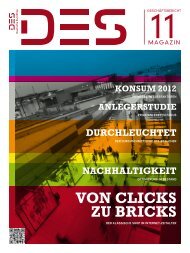Financials - Deutsche EuroShop
Financials - Deutsche EuroShop
Financials - Deutsche EuroShop
Create successful ePaper yourself
Turn your PDF publications into a flip-book with our unique Google optimized e-Paper software.
ConSoLIDAteD FInAnCIAL StAteMentS financial instruments<br />
1. DERIvaTIvE FINaNCIal INSTRuMENTS<br />
Derivatives that qualify for hedge accounting in accordance with IAS 39 are used to hedge interest rate risks. These are fixed-rate swaps to limit<br />
the interest rate risk of variable interest rate loans, which have terms extending to 2026. The interest rate hedges are recognised at fair value under<br />
“Other assets” or “Other liabilities”. Changes are recognised directly in equity, provided that the conditions of the underlying and hedge transaction<br />
are identical. Hedge effectiveness tests are regularly conducted. Present value is calculated based on discounted cash flows using current<br />
market interest rates. The final maturities of the interest rate hedges and loan agreements are identical.<br />
2. NON-CuRRENT FINaNCIal aSSETS<br />
Non-current financial assets are classified as available for sale and include an investment in a Polish corporation that is a joint venture controlled<br />
by <strong>Deutsche</strong> <strong>EuroShop</strong> jointly with partner companies. As <strong>Deutsche</strong> <strong>EuroShop</strong>, under the provisions of the shareholders’ agreement, exercises<br />
neither significant influence nor control over this company, the investment is measured at fair value in line with the provisions of IAS 39. Measurement<br />
gains and losses are recognised directly in equity. Fair values of financial instruments for which there are no quoted market prices are<br />
estimated on the basis of the market values of the properties determined by appraisals, less net debt. The determination of fair value assumes the<br />
existence of a going concern.<br />
3. INvESTMENTS IN EquITY-aCCOuNTED aSSOCIaTES<br />
Companies with a narrow scope of business in which <strong>Deutsche</strong> <strong>EuroShop</strong> generally has an interest of between 20% and 50% and over which it<br />
exercises significant influence but not control are measured as equity-accounted associates. Here, the changes in the equity of such companies<br />
corresponding to the equity interest of <strong>Deutsche</strong> <strong>EuroShop</strong> are recognised in income.<br />
4. RECEIvaBlES aND OThER CuRRENT aSSETS<br />
Receivables and other current assets are recognised at amortised cost less write-downs. Allowances are established for trade receivables if it is no<br />
longer certain that payment will be received. This is reviewed on a case-by-case basis at the balance sheet date. They are written off if the receivable<br />
becomes uncollectible.<br />
5. RIGhT TO REDEEM OF lIMITED paRTNERS<br />
The distinction between equity and liabilities is set out in IAS 32 Financial Instruments: Disclosure and Presentation. In accordance with this<br />
standard, the equity interests of third-party shareholders in commercial partnerships are reclassified as liabilities due to the shareholders’ potential<br />
right of redemption. According to sections 131 et seq. HGB, shareholders in commercial partnerships have an ordinary legal right of termination<br />
of six months with effect from the end of the financial year, which the shareholders’ agreement can define in greater detail, but not exclude. As a<br />
result of this stipulation, a liability rather than equity is recognised in the balance sheet. This liability must be measured at fair value.<br />
6. BaNK lOaNS aND OvERDRaFTS<br />
Liabilities to banks/bank loans and overdrafts are reported at amortised cost. Discounts are deducted, which under IAS 39 must be amortised<br />
over the term of the loan agreement and recognised annually as an expense.<br />
7. TRaDE paYaBlES<br />
Trade payables are recognised at their repayment amount.<br />
40 Des Annual Report 2011





